
Laffite Automobili and GFG Style, who were commissioned to design the new Italian manufacturer's full family of cars, will unveil five electric hypercar models (three specific architectures and two further evolutions) on Wednesday, 3 May, during the week of the Formula 1 Grand Prix in Miami.

Over a period of less than six months, GFG Style has developed a new and consistent style that spans an entire family of cars and has been tailored to each of the architectures.
Under Fabrizio Giugiaro's stylistic direction, GFG Style designed and developed the ATRAX, an extreme hyper SUV (2+1) withstanding also extreme off-road use, and a more road-going version named ATRAX STRADALE.
The BARCHETTA is unique, with its double windshield and separate cockpits; which, with the closed variant, it alters its appearance and becomes the BARCHETTA Coupé, a completely stand-alone model.
By contrast, the Laffite LM1 is a sports car that has been derived from endurance racing but is street-legal.
FABRIZIO GIUGIARO DESCRIBES THE PROJECT
I created the architecture and design layout of this 'new family of hypercars' by defining the stylistic features that would identify the new Laffite Automobili brand and deploying them on all five models.
So, that was the real challenge I faced: to design original cars with entirely different and unique traits.
The first objective: the front of the car and the way its light clusters express the brand's image.
"Here comes a Laffite!"

The front views of all five models feature the same design sequence: a low spoiler, a horizontal bar embedding the light clusters, air intakes on distinctly contoured hoods and, most notably, the brand’s signature DRL lights.
The halo was designed by drawing inspiration from safety innovations adopted in motor racing. While this is very obvious on the BARCHETTA, it also constitutes a very distinctive feature of the entire brand.
The B pillars on the sides exhibit the same graphic theme but with distinctly different proportions and functions.
In contrast, the rear is more customized, sharing many functional elements, such as the diffuser and the spoilers that incorporate the typical rear light of a Formula 1 model.
With regard to the interior, all the models share the same styling language and use the same features, including custom-designed vents and ceiling lights.
ATRAX and ATRAX STRADALE
The design of both the Atrax and the Atrax Stradale stems from my extensive experience as a designer and a new area I had already started exploring some ten years ago. As I often do when looking at the future, besides my design work, I also try to create new types of cars such as the hyper SUV. Today, at last, automakers too are launching similar models on the market. However, in the case of Laffite Automobili we have already gone a step further, both in terms of design and usability.

Atrax is intended to be a sporty SUV featuring exceptional and extreme shapes, with generous volumes and spacious interiors that accommodate a 2+1 seat architecture - quite a surprise!
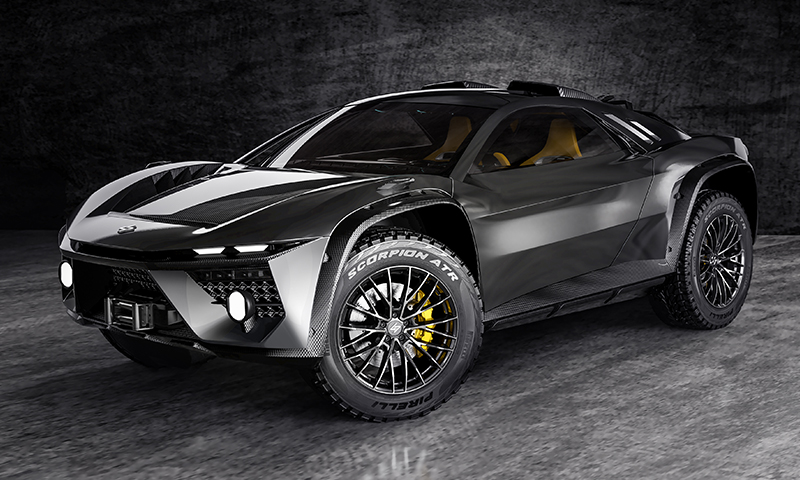

It all starts with huge all-terrain wheels almost a meter in diameter, imposing fenders, and stylish, exposed carbon wheel arches.
The side view is effortless, with a well-proportioned beltline, a door that swings up like a butterfly and a single window that can be lowered normally.
The unique feature of the door is the “detached” A-pillar that doubles as an aerodynamic element positioned where the airflow is most critical, creating a unique design.
The B-pillar is also “detached” from the body and acts as an aerodynamic wing, complemented by two air outlets.
The exposed carbon sill features three highly graphic steel elements, which protect against any contact with the ground.
The front end is designed to be highly functional: fins above the fenders and a central wing that conceals the side lights. In addition, the winch, a typical feature of off-road cars, is integrated below the radiator air intake and is also specially designed for the car.
In the rear, one can see the two differences between the Atrax and Atrax Stradale. The former has the exterior spare wheel supported by a spider-like structure, which doubles as a hydraulic system that can lift the large spare wheel.


Conversely, the rear of the ATRAX Stradale features streamlined wings and accommodates a spacious trunk.


Both feature an end wing integrated into the fenders, while a red strip of lights separates the sport-derived round tail clusters.
Also notable is the height-adjustable aerodynamic diffuser, which lowers at high speeds.
INTERIORS
The ATRAX is primarily defined by the total use of volume (2+1) with unprecedented interior space. Its design takes into account the fact that the seats are fixed but height adjustable. The pedals and steering column can be adjusted by 180 mm for a perfect driving position. The four-point seat belts are fixed, and as a result, one can reach all the dashboard controls without needing to move one's body.

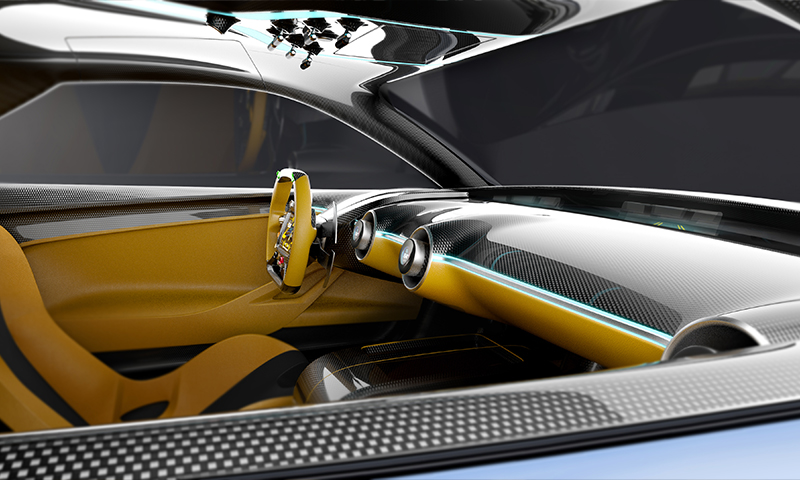
The wing-shaped, horizontal sports dashboard has a dark, carbon-printed leather upper part and a yellow sports leather lower part, separated by a chrome strip that integrates the four individually adjustable air vents.

Above the dashboard, an under-windshield eyelid integrates the three displays that offer views to the rear and sides of the car. Here too, the wing mirrors have been replaced by cameras. Their placement is designed to have the rear view immediately after the front view, without moving one's head.
The door panel design is simple and minimalist, incorporating a convenient storage compartment. There are no movement control knobs, as these would be out of reach when the door opens. Consequently, a top-mounted central dashboard has been designed for convenient access to all controls at all times.
A specially designed removable trolley, integrated into the central tunnel, separates the passenger from the driver and provides convenient storage and twin cupholders.
All the car's controls are placed on the futuristically designed steering wheel, which incorporates a central multifunction display.
The yellow leather seats with carbon moulded leather inserts are also supremely sporty yet extremely comfortable and feature ‘spider-like' graphics.
LM1
The LM1's mission is to give substance to an idea by creating the form for a vehicle intended primarily for racing but also street-legal while also introducing unexpected comfort for everyday use.


The lines are designed by the wind, but every stylistic detail is carefully studied to make it even more attractive and compromise-free. The low front is clearly characterized by the Laffite family headlights. The central part of the hood is black and contains a large central air outlet, while active fins are cut into the painted fenders.
The very narrow cockpit is shaped like a teardrop and has a maximum width of 90 cm, as required by racing regulations for cars of this type.
The wrap-around windscreen continues into the doors creating the side windows that slope down to the B-pillar, with graphics similar to those of the Atrax hyper SUVs, but that, in this case, results in two small windows.
The cockpit is narrow along the length of the side and slopes down to the diffuser at the rear. It has the unique feature of having two pillars above it with a dual function: the first to support the large active spoiler and the second to channel the aerodynamic flow better. This is a real innovation that I would bet we will soon be seeing in future racing cars.



The side has a very broad shoulder, unique in its kind, which towards the rear, integrates with the side parts of the large active spoiler (DRS type), also incorporating the rear lights.
The rear is thoroughly technical, with its design focused on functionality and aerodynamics.
The side air outlets conceal the charging connectors and the integrated lifting system behind the grille.
INTERIORS
The interior provides a striking first impression thanks to the two staggered seats, a distinctive feature of the cabin.
The dashboard is wing-shaped with the same layout as the rest of the Laffite family, with the upper section in black carbon-printed leather and the lower section in blue Alcantara, separated by a strip of light that combines a central air vent with a display.
The door panels are asymmetrical due to the staggered seats and have individual air vents with displays. Only the passenger has a grab handle.
Again, all door and window opening functions are situated in the overhead center console.
In addition to a central multifunction touch screen, the steering wheel incorporates all the controls of a real racing car but with a stylish design in every detail.
Monitors built into the dashboard provide exterior views on the LM1 as well.
The seats are fixed and can only be adjusted in height, while the pedals and steering column can move 'towards' the driver. They feature blue Alcantara cushions over carbon seat shells that can be easily customized.

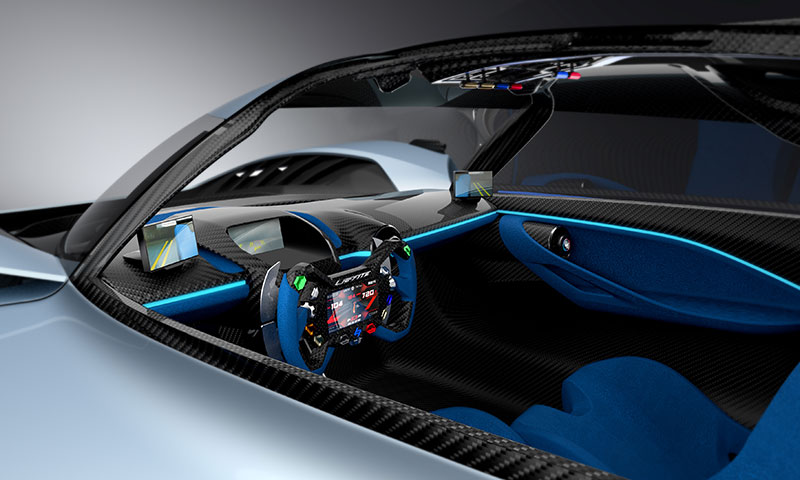

BARCHETTA and BARCHETTA COUPÉ
The Barchetta and Barchetta Coupé project is the most complex in all respects and features a surprising innovation.


The Barchetta has two distinctive hallmarks: two separate seats with two individual windscreens and a Formula 1-derived halo. This ensures exceptional safety and is decidedly unusual for an open, street-legal car.
The double windscreen choice was inspired by my father Giorgetto's idea in 1959, which was later revived in the 1988 Aztec prototype.


The most recent formal experiment with a similar scheme was proposed with the 2020 Dora concept car, which was actually the initial step in this project. So we attach great value to our advanced research into concept cars, which we never view as an end in themselves.
The double cockpit crowned by the large Halo-like structure marks the absolute design novelty.
To access the interior, the two cockpits lift independently but simultaneously as the doors, creating a spectacular movement.
The front end maintains the Laffite styling cues with the distinctive, well-defined twin headlights separated by a large integrated wing.
The stylistic element of the design is clearly the arched structure that gives the side line continuity in its upper part and rests on the large wing-shaped B-pillars.
The side design is straightforward but emphasized in the large rear wing.
The rear features a continuous upper tail light that doubles as a wing beneath which an exposed carbon component integrates the three elements on each side, providing additional functions to the tail light.
The tail part ends high up with a spoiler connected to both extremities.
INTERIOR
The innovative interior styling comes from the design of the two separate and closable cockpits. The refined design is evident in details such as the centre console, where, in addition to the door functions, there are also two air vents with an integrated display, and in the panels that also feature integrated air vents. The stylistic break between the door panel and the console is symmetrical.
The separate driver and passenger instrument panels reflect the same style as the other models, featuring a carbon-moulded leather upper part and a beige leather lower part separated by chrome mouldings and sophisticated lighting.
There are three monitors on the driver's side for rear and side vision, while the passenger can also use their monitor for other functions.
The steering wheel is high-tech but with a sophisticated design and incorporates all the vehicle's controls in the central touch display, just like a racing car.
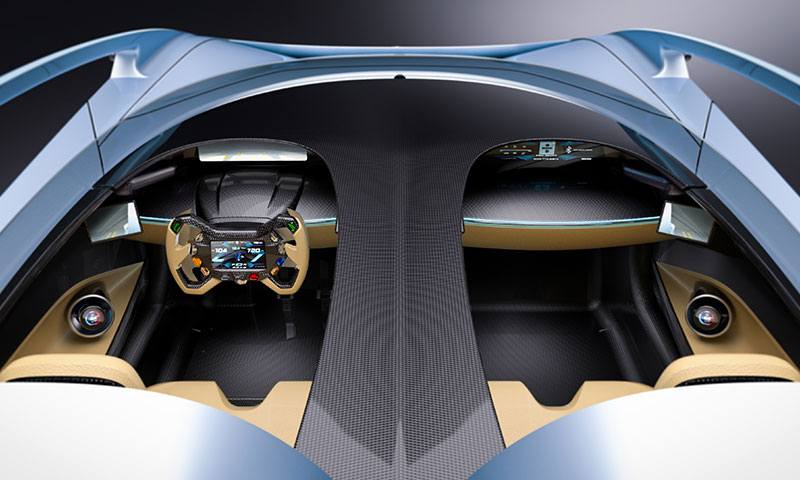

The fixed but height-adjustable seats with beige and black carbon-printed leather upholstery are all about comfort and sporty elegance. In addition, the steering column and pedals are adjustable for ultimate ergonomics.
BARCHETTA COUPÉ
It is a coupé with its own great personality based on the open version: a single windscreen encloses both driver and passenger. Moreover, the removable carbon roof provides it with an unusual and original appearance.

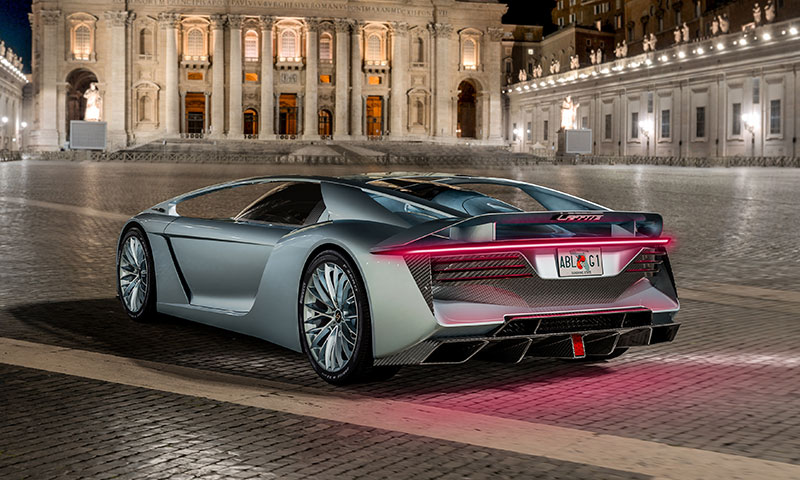

The interior echoes the Barchetta's styling cues, with a single space separated by a central structure.
The Barchetta Coupé combines innovation, elegance and originality.